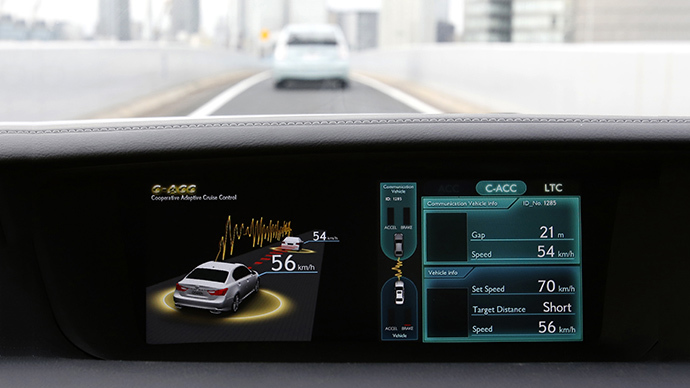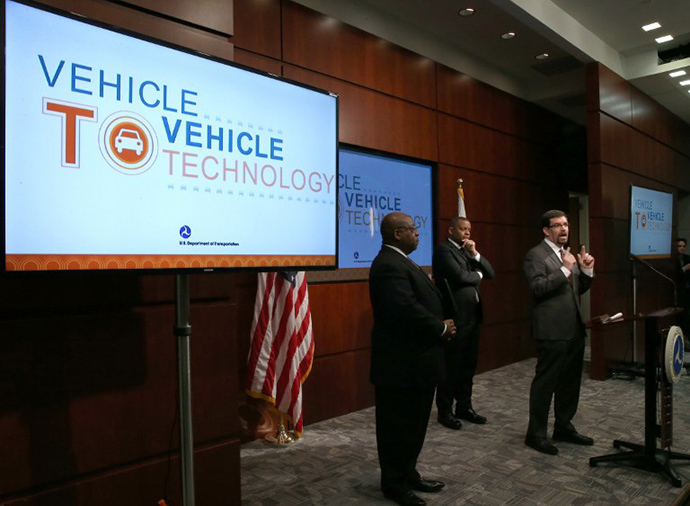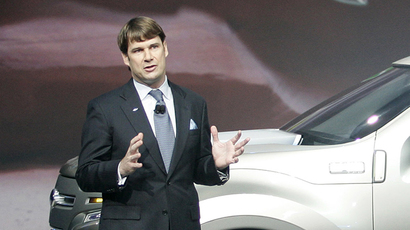Cars that speak to one another? Tech on the way, but privacy concerns remain

US officials said Monday that, to improve safety, they will soon propose requiring automakers to equip all new cars and light trucks with technology that allows vehicles to communicate with each other. Yet privacy concerns, among others, must be resolved.
Vehicle-to-vehicle (V2V) feedback would occur over a special wireless frequency called Dedicated Short-Range Communications (DSRC), allowing a vehicle to consistently transmit its location, heading, speed and other information. In turn, that vehicle would receive the same data from other vehicles with the aim of avoiding impending collisions. Some systems may allow operators to choose whether to allow the vehicle to automatically brake in the event of an impending accident.
US regulators will soon begin constructing guidelines for such technology, US Transportation Secretary Anthony Foxx said Monday at a press conference at the Department of Transportation’s headquarters.
"Keeping drivers safe is the most important advantage of V2V, but it's just one of many," Foxx said, according to Automotive News. "V2V can also help reduce congestion and save fuel. The potential of this technology is absolutely enormous."
The National Highway Traffic Safety Administration has worked with automakers over the past decade on DRSC technology, officials said. Safety administration head David Friedman emphasized that with DRSC, the government’s top focus regarding road safety will be preventing accidents rather than just working to make car collisions survivable. The federal agency says DRSC could prevent 70 to 80 percent of crashes that do not involve impaired drivers or mechanical failure.

Officials made clear, though, that it will be at least several years before automakers would have to put the technology in vehicles. The safety administration plans to offer a report this month on its research thus far, then it will allow the public and vehicle manufacturers to comment for the following 90 days.
While not adhering to a target date for the mandate, Foxx said he hopes to have a regulatory proposal by the end of President Barack Obama’s current term. For now, the announcement works to "send a strong signal to the (automotive industry) that we believe the wave of the future is vehicle-to-vehicle technology,” Foxx said, according to AP.
Yet many obstacles and concerns remain despite the lofty talk of the benefits that lie ahead for DRSC’s use. Safety benefits, for instance, will remain unrealized until a critical mass of vehicles on the road use the technology, which could take several years. Some benefits could be seen with just 7 to 10 percent of vehicles containing the technology, according to a spokesman for the Intelligent Transportation Society of America, AP reported.
Top lobbying organization for automakers, the Alliance of Automobile Manufacturers, said that while DRSC will likely have many benefits, the group would prefer a voluntary agreement instead of a government mandate.
"DSRC radios may play a larger role in future road safety, but many pieces of a large puzzle still need to fit together," Gloria Bergquist, a spokeswoman for the Alliance, said in a statement. "We need to address security and privacy, along with consumer acceptance, affordability, achieving the critical mass to enable the 'network effect' and establishment of the necessary legal and regulatory framework."
Indeed, privacy and security issues hang in the balance. For an existing precedent, global positioning systems (GPS) - which have existed in vehicles for years now but are expanding rapidly as more smart technology proliferates - already allow automakers access an array of personal data. Earlier this month, Ford executive Jim Farley made waves when he said at a trade show, “We know everyone who breaks the law, [and[ we know when you're doing it.” He added, “We have GPS in your car, so we know what you're doing,” underscoring how vulnerable vehicle users and owners already are.
He subsequently offered a clarification of the remarks. "I absolutely left the wrong impression about how Ford operates. We do not track our customers in their cars without their approval or their consent,” he said.
Smartphones have been said to be an option to hasten the emergence of the technology, which could be required on half of vehicles by a government mandate within 15 years. Smartphones, which already have GPS, could be equipped with a radio chip that could be used to retrofit older vehicles, allowing them to communicate with other vehicles.
While using phones could also extend DRSC benefits to pedestrians and bicyclists, for instance, they also pose privacy and safety hurdles of their own based on the short lifespan of phone batteries and the relative ease with which they can be stolen, hacked or have data syphoned. In addition, they may need to be fitted with antennas to reach proper radio frequencies.
Regardless of whether a smartphone is used to coordinate vehicle-to-vehicle communication, Richard Bishop, a consultant on automation in vehicles, said much of the same privacy concerns involved in phones exist in DRSC by itself.
"Nothing is airtight," Bishop told Automotive News, "but that's just the world we live in."
Manufacturers are already working to put their own unique stamp on alert systems outside of normal auditory cues and flashing-light symbols. General Motors, for example, has a patent on a vibrating seat to warn drivers of danger; while Ford uses a vibrating steering wheel.
Proponents of wireless DRSC say it could also be used to collect tolls, or to tax drivers depending on the number of miles driven, as opposed to gasoline or diesel taxes.
"It will change driving as we know it over time," said Scott Belcher, president and CEO of the Intelligent Transportation Society of America, according to AP. "Over time, we'll see a reduction in crashes. Automobile makers will rethink how they design and construct cars because they will no longer be constructing cars to survive a crash, but building them to avoid a crash."
Government officials did not estimate how much DRSC technology would increase the price of a new vehicle, but the transportation society believes it would cost around US$100 to $200 per car.














